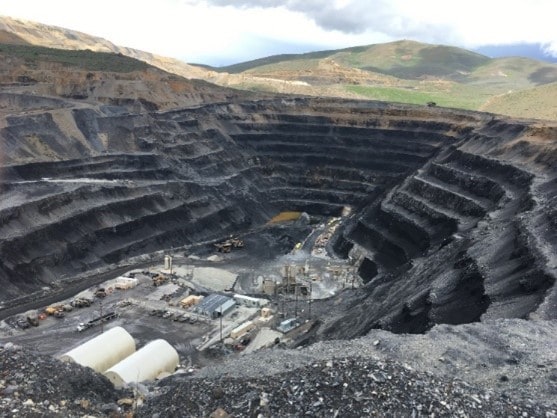Mining Project: Highwall Safety: Rockfall Catchment Design and Slope Performance Monitoring at Surface Mines and Quarries
| Principal Investigators |
|
|---|---|
| Start Date | 10/1/2021 |
| Objective |
This project intends to increase the safety of open pit mines through (1) improving upon or developing new rockfall catch bench design guidelines to aid design engineers in matching rockfall catch bench performance to acceptable risk criteria specific to unique mining situations; and (2) improving slope performance monitoring capabilities at open pit and quarry sites by expanding on slope monitoring radar alarm/notification setting guidelines, working with vendors on improvements to existing monitoring technologies and improving/expanding their use in surface mines and quarries. |
| Topic Areas |
Research Summary
Catch bench design guidelines will be developed primarily through rockfall testing in a range of bench configurations to develop an empirical database of catch bench performance while documenting bench configuration and other variables affecting runout distance catch bench performance. The intent is to use the database to build a predictive empirical model to aid design engineers and help match catch bench performance requirements to rockfall hazard risk acceptance criteria. Partners from the mining industry are heavily involved in the planning and execution of this task, and these partners include mining consultants from Piteau Associates, Geobrugg & IDS GeoRadar, and mining companies such as Kinross and Nevada Gold Mines.
In conjunction with recognized industry experts, the project team will develop a database of monitored slope movement and failures that can be analyzed to gain insight into slope behavior and aid in improving current slope behavior forecasting tools. The main goal is to make advances on monitoring alarm trigger threshold settings and give guidance to professionals tasked with monitoring slopes and developing Trigger Action Response Plans (TARPS) that dictate changes in operations based on slope movement thresholds. Another task is to increase awareness of InSAR (satellite-based radar) slope monitoring and explore new rockfall tracking and detection technologies in development. The main collaborators on this task are the Geotechnical Center of Excellence at University of Arizona, IDS GeoRadar, and SkyGeo.
The project works in close collaboration with the Geotechnical Center of Excellence (Industry Consortium) https://minerals.arizona.edu/innovation/geotechnical-center-excellence, which develops international courses on slope monitoring and design.
Milestones and Accomplishments
| Description | Audience | Year |
|---|---|---|
| Improve on or develop new guidance for rockfall catch bench width and overall bench configurations | Slope design engineers and anyone involved in rockfall risk mitigation at mines | 2025 |
| Update guidance on slope monitoring alarm thresholds and development of Trigger Action Response Plans (TARPS) | Monitoring system manufacturers and geotechnical engineers at mining operations | 2026 |
| Hold workshop in conjunction with industry experts: Mine pit slope safety: Design and monitoring of pit slopes in mining | Health and safety professionals and geotechnical engineers | 2026 |
Planned Impacts and Outcomes
The primary planned outcomes of this project research are as follows:
- Increased adoption of rockfall catch bench design guidelines by mining operations to reduce fatalities and injuries caused by rockfall.
- Increased adoption of slope monitoring trigger/alarm notification guidelines by mine operations and consultants in the industry.
- Increased adoption of InSAR monitoring as a cost-effective way to monitor site-wide ground movement.
Outputs
Warren S, Chambers D, Stopka C, Armstrong J [2021]. Catch bench design to mitigate rockfall hazards: revisiting the Modified Ritchie Criterion (presentation). SME Annual Meeting, Mar 1–Feb 5, 2021, Virtual: Society for Mining, Metallurgy, & Exploration.
Bourgeois J, Warren S, Armstrong J [2022]. Utilization of statistical analysis to identify influential slope parameters associated with rockfall at open pit mines. SME Annual Meeting, March 28–Feb 2, 2022. Salt Lake City: Society for Mining, Metallurgy, & Exploration.
Warren S, Bourgeois J, Sweet D, Sbai S, Brackebusch A, Stopka C, Armstrong J [2022]. Revisiting rockfall catch bench design criteria: Initial rockfall testing results from the Golden Chest mine, ID. Slope Stability Conference, Tucson AZ, Oct 17–22, 2022.
Sbai S, Bourgeois J, Warren S, Stopka C [2022]. Development of a comprehensive slope failure database for open pit mines. Slope Stability Conference, Tucson AZ, Oct 17–22, 2022.
Supporting Visual

Open pit operations will sometimes place a portal within the pit and develop underground workings to continue mining ore that the pit cannot recover. These situations will likely have different rockfall safety requirements compared to a pit that will be abandoned. Project researchers intend to develop rockfall catch bench design guidelines that can tailor the design to specific rockfall catch bench performance requirements depending on the specific mining situation.
- Analysis of Bench Crest Performance at the Yellowstone Mine: A Case Study
- Applications of Ground-Based Radar to Mine Slope Monitoring
- Applications of the Point Estimation Method for Stochastic Rock Slope Engineering
- Assessing and Monitoring Open Pit Mine Highwalls
- Detecting Problems With Mine Slope Stability
- NIOSH Computer Programs for Bench Crest Failure Analysis in Fractured Rock
- Open Pit Highwall Safety
- A Portable Spectro-Polarimetric Imager: Potential Mine Safety and Geologic Applications
- Shear Strength Evaluation of Clay-Rock Mixtures
- Technology News 516 - ARMPS-HWM: New Software for Sizing Pillars for Highwall Mining